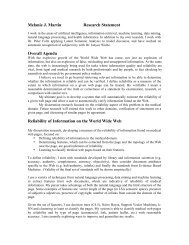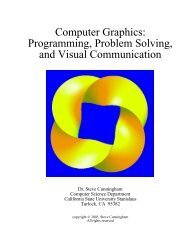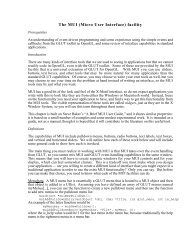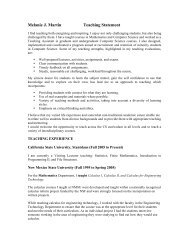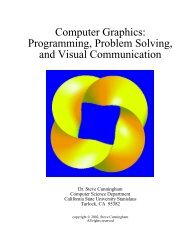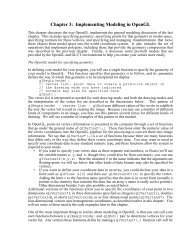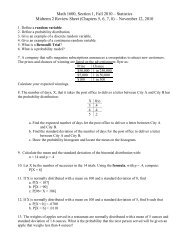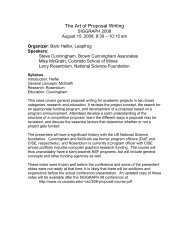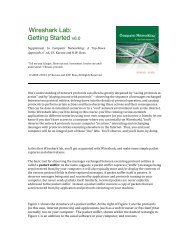ANTH 2080-01
ANTH 2080-01
ANTH 2080-01
You also want an ePaper? Increase the reach of your titles
YUMPU automatically turns print PDFs into web optimized ePapers that Google loves.
Fall 2006<br />
Anthropology <strong>2080</strong><br />
Introduction to Physical Anthropology<br />
Professor Sari Miller-Antonio<br />
smillerantonio@csustan.edu<br />
Office: C215; 667-3604<br />
Office Hours: M 1:30 – 3:30, W 1:30 - 3 (or by appointment)<br />
Course Content and Format<br />
This course is an exploration of the field of biological anthropology from genetic, evolutionary,<br />
behavioral and cultural perspectives. Topics include: the development of evolutionary theory; the principles<br />
of inheritance, human variation and adaptation; the study of non-human primates; and the fossil record of<br />
human evolution.<br />
In the early part of the course we investigate the biological bases for human evolution. With this<br />
foundation, we will go on to study our nearest living relatives, monkeys and apes, with an emphasis on social<br />
behavior of these animals. Next, we examine the human fossil and archaeological record with a focus on the<br />
evidence for the beginnings of complex cognitive human behaviors. We end the semester with a look at<br />
human diversity and some timely issues in the field.<br />
Learning Goals - After completing this course, students will:<br />
• Understand the application of the scientific method (i.e. how to formulate and test hypotheses)<br />
• Understand the theory of evolution at both the molecular level and the level of the organism<br />
• Understand the fossil evidence for primate and human evolution<br />
• Understand the interdisciplinary nature of this field<br />
• Gain an appreciation for the biological bases of human and non-human primate behavior<br />
Course Requirements and Grading Policy<br />
There will be four exams each equally weighted at 100 pts. Exam material comes from your text, lecture<br />
material, articles and video material presented in class. Your lowest test grade will be dropped but there will be<br />
no curve.<br />
Attendance: It is important that you come to class. If you miss a class, it is your responsibility to obtain<br />
missed lecture notes from a classmate.<br />
Annual Editions Article – (see last page of this syllabus). Pick an article, read it, then take it one step further<br />
and find a related report/story/news segment. Present the main points of your article and related information in<br />
class. Turn in a short (one page) summary. 50 points<br />
Ice Breaker internet exploration: “Anthropology on the Web” Go to the online textbook site and click on<br />
web links for any chapter that interests you. (Sept. 11 – 25) 25 points. Find your green number in the upper<br />
right corner of this syllabus. Here is the schedule: 9/11 (#1), 9/13 (#2), 9/18 (#3), 9/20 (#4), 9/25 (#5)<br />
http://anthropology.wadsworth.com/jurmaine6e_ess<br />
Anthropology in the News and Mass Media – Scrapbook, film, or (popular) book choice. We’ll talk about<br />
what you’ve found on the last day of class – Dec. 6. ** You must show up to participate in this final class<br />
discussion to earn the full 50 points. Turn in short written narratives by Wednesday of final exam week..<br />
1
Total possible points: 425 (your grade will be determined as a percentage of the total possible points)<br />
The +/- grading system will be used for final course grades.<br />
Required Texts:<br />
Essentials of Physical Anthropology by Jurmain, Kilgore, Trevathan, Nelson sixth edition. Chapters are assigned<br />
by lecture topic. There is a study guide for this text but it is not required and there is plenty of web support for the<br />
material. The text and the study guide are on reserve in the library.<br />
Annual Editions: Physical Anthropology 05/06 (McGraw Hill 2004) – Articles are assigned by date. (Everyone<br />
must read all assigned articles but each student will serve as presenter/discussion leader for only one)<br />
DATES TOPICS CHAPTERS<br />
Sept. 6 , 11, 13<br />
Course Introduction and Expectations<br />
What biological anthropologists do<br />
How and why we do it<br />
1<br />
The Development of Evolutionary Thought 2<br />
Darwin & Natural Selection<br />
Video: What Darwin Never Saw<br />
Sept. 18, 20, 25<br />
The Biological Basis of Life<br />
3<br />
Molecular Genetics<br />
Mendelian genetics and inheritance 4<br />
Annual Editions Present Articles # 4, 3, 7, 8 (9/25)<br />
Review for exam<br />
Sept. 27 Exam 1 (chapters 1-4, lecture materials, A.E. articles)<br />
Oct. 2 Macroevolution: Processes of Mammalian Evolution 5<br />
Classification<br />
Oct. 4, 9<br />
Primate Taxonomy<br />
Survey of the Living Primates 6<br />
Endangered Primates<br />
Annual Editions Present Articles # 13, 37 (10/9)<br />
Oct. 16, 18, 23 Primate Behavior 7<br />
Special Topics: Evolution of Language; Aggression<br />
Various video clips<br />
Annual Editions Present Articles # 9, 11, 15, 29 (10/18)<br />
Annual Editions Present Articles # 16, 17, 19 (10/23)<br />
Review for exam<br />
Oct. 25<br />
Exam 2 (chapters 5-7, lecture materials, articles)<br />
Oct. 30, Nov. 1 Early Primate Evolution and Miocene Fossil Apes 8<br />
Dating Methods in Paleoanthropology<br />
Paleoanthropologists in the field (short video),<br />
The earliest African hominids<br />
2
Bigger Brains and the earliest Homo<br />
Annual Editions Present Articles # 20, 21 (11/1)<br />
Nov. 6, 8 Homo erectus: Fossil casts and morphology 9<br />
Homo erectus dispersals - discoveries in Asia and Europe<br />
Archaeological sites, technology and culture<br />
Annual Editions Present Articles #25, 22 (11/6)<br />
Nov. 13<br />
Nov. 15<br />
Nov. 20, 22<br />
A Big Cave in Rural China (Miller-Antonio’s research)<br />
Review for exam<br />
Exam 3 (chapters 8 and 9, lecture materials, articles)<br />
Archaic Homo sapiens: Middle Pleistocene humans in Africa, 10<br />
Europe, and Asia<br />
Neandertals: Upper Pleistocene humans in Europe<br />
Annual Editions Present Article # 28, 31 (11/22)<br />
Nov. 27, 29<br />
Origin and Dispersal of Modern Humans: Competing Models 11<br />
Technology and Art in the Upper Paleolithic<br />
Annual Editions Present Articles # 30, 32 (11/29)<br />
Dec. 4 Modern Human Variation and Adaptation 12<br />
The Race Concept<br />
Annual Editions Present Articles #33, 39 (12/4)<br />
Dec. 6<br />
Anthropology in the News and Mass Media – in class discussion<br />
Turn in short written narratives by Wednesday of Final Exam Week.<br />
Evaluate this course<br />
D ec. 15 Exam 4 (chapters 10, 11, 12, lectures, articles)<br />
9:00 – 10:00<br />
3
Please look over these choices and indicate your first, second and third preference.<br />
Turn this form in on Monday, Sept. 11. Name: __________________________________<br />
Date<br />
Annual Editions Article<br />
Sept. 25 Why Should Students Learn Evolution #4<br />
15 Answers to Creationist Nonsense #3<br />
Of Mice, Men and Genes #7<br />
The Drunken Monkey Hypothesis #8<br />
Oct. 9 How Animals do Business #13<br />
An Open Door, A Forest…. #37<br />
Oct. 18 What Are Friends For? #9<br />
Got Culture? #11<br />
A Telling Difference #15<br />
The Gift of Gab #29<br />
Oct. 23 Mothers and Others #16<br />
Had King Henry VIII’s Wives Only Known #17<br />
Apes of Wrath #19<br />
Nov. 1 The Salamander’s Tale #20<br />
Hunting the First Hominid #21<br />
Nov. 6 Food for Thought: Dietary Change in Human Ev. #22<br />
Born to Run #25<br />
Nov. 22 Rethinking Neanderthals #28<br />
The Morning of the Modern Mind #31<br />
Nov. 29 We Are All Africans #30<br />
The Littlest Human #32<br />
Dec. 4 Skin Deep #33<br />
Inuit Paradox #39<br />
4





